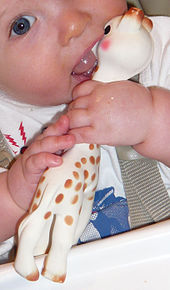Have you ever wondered how infants go from communicating via crying, to nonsensical noises, to single syllables, and eventually to words? Well, it turns out infants’ language learning is linked to being able to move their tongue when hearing the sounds: tongue movement isn’t just necessary for *making* speech sounds– it also helps babies *understand* them! In 2015, Dr. Alison Bruderer and her colleagues performed a study on six-month-old, pre-lingual infants from English speaking households. They exposed the children to two different Hindi “D” sounds which they had never heard before. When the infants were able to move their tongues as they listened to the different sounds, they could distinguish between the two sounds. However, when the infants held a teething toy in their mouth that prohibited tongue movement, the infants couldn’t tell the sounds apart. Bruderer’s study provided evidence that the oral sensorimotor system that controls tongue movement has a direct impact on auditory perception and speech development. This system gives infants the ability to discriminate sounds and eventually learn how to produce them.
Learning how to make a speech sound takes practice: you have to coordinate your tongue, lips, and teeth to move in harmony. In order to one day make the sounds they’re hearing, infants must practice making the mouth shapes needed to produce the sounds. These rounds of practice also come out as babbling (side note: babies learning a sign language also babble with their hands!). If your child always has a teething toy in their mouth, they may not be getting a lot of practice in!

It’s not just babies who need to practice making new tongue movements: Dr. William Katz led a study in 2015 which found that English-speaking adults learning a new language with foreign sounds also had a difficult time producing the new sounds (you probably understand if you’ve ever taken a foreign language class). But, seeing 3-dimensional images of where to position the tongue made it much easier for adults to make the sound.
Another study performed in 2006 by Dr. Katie Alcock also found a correlation between a type of speech production difficulty (nonfluent developmental dysphasia) and an early difficulty in coordinating mouth movements in general (oral dyspraxia). This study further supports the connection between mouth movement and language development, and concluded that children who have troubles with mouth movements as babies are the same ones who have troubles pronouncing new words up to age 10!
Now, before you reach for the trash can, it’s too early to say that this research means that parents should get rid of teething toys altogether, and longitudinal studies are needed to find out if less tongue movement in infancy and early childhood leads to a delay in language development. However, given this newfound importance of tongue movement in speech perception, Bruderer and other researchers in the field are curious about what implication this phenomenon has on individuals with oral malformations, such as cleft palate, and their language learning journeys.
References
Alcock, Katie. (2006). The development of oral motor control and language. Downs Syndr Res Pract 11(1), 1-8. doi: 10.3104/reports.310.
Bruderer, Alison G; et. al. (2015). Sensorimotor influences on speech perception in infancy. Proceedings of the National Academy of Sciences, 112(44), 13531-13536. https://doi.org/10.1073/pnas.1508631112.
Intagliata, Christopher. (2015). Babies Move Tongue to Learn New Tongues. Scientific American. https://www.scientificamerican.com/podcast/episode/babies-move-tongue-to-learn-new-tongues/.
Katz, William F. & Mehta, Sonya. (2015). Visual Feedback of Tongue Movement for Novel Speech Sound Learning. Frontiers in Human Neuroscience, 9(612). https://doi.org/10.3389/fnhum.2015.00612.
Knight, Meredith. (2016). Do teething toys disrupt how babies learn language? Scientific American. https://www.scientificamerican.com/article/do-teething-toys-disrupt-how-babies-learn-language/.
Anika Pawlak
Author
Anika is a junior at Duke!